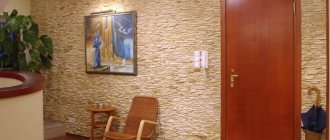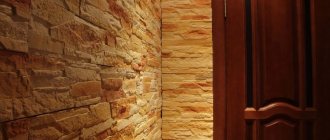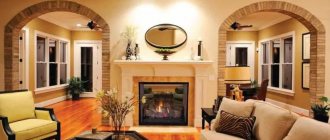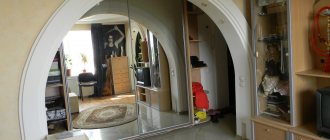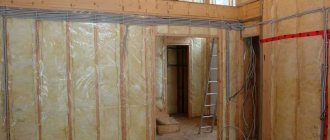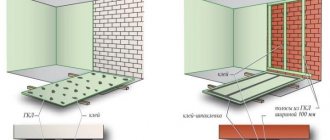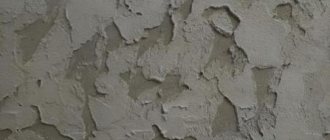Plastering the basement of a house: photos and videos
Stone plinth plaster imitates masonry of various textures, character and colors. The most common and accessible for repetition are the following:
- Smooth blocks of the same shape. Imitation of block masonry.
- Hewn stone of various shapes. Even “bricks” of different sizes.
- Uneven large stone (torn rubble). The most popular and simplest base “stone” plaster. Stones with polygonal shapes are “laid” in 1-2 rows. The most convenient drawing in situations where it is not possible to do the work painstakingly.
- Medium sized stone. Small equal rubble, limestone. The most harmonious: it has a believable drawing full of details, but is relatively simple and quick to implement.
- Small elements. Not cladding, but masonry with sandstone (“plaster”). Many rows of untreated small stones.
- Pebble. “Facing” with sea, river stone, “ground” by waves, rounded.
All these forms are available for amateurs to repeat on their own. The nature of the drawing requires only a certain sense of harmony, which is inherent in most people, even those who are not capable of drawing. Plastering a plinth to resemble a stone with your own hands is no more difficult than conventional finishing.
The main thing is to achieve believability, to avoid clearly noticeable repetitions of the design, its distortions, unusual chips, and their too precise fitting to each other.
Ways to imitate a stone wall
So, let's look at what you can use to make a wall in your house or apartment like in an ancient castle. If we do not take into account the cladding made from natural prepared material, then there are several popular methods of imitation:
- From tiles . This does not mean tiles, but relief tiles made from gypsum or cement-sand mortar. Artificial stone is sold ready-to-use, already painted, and is used for interior decoration and on facades. Most often this is an imitation of torn slate, limestone (travertine), dolomite, sandstone or rock. You can make such tiles yourself by pouring the solution into rubber molds. But this is a labor-intensive process that requires special equipment (vibrating table) and painting materials for high quality.
- Stone-effect hinged panels . Plastic panels are often used for cladding the facade of a building. The advantages of this method: speed of work, practicality, attractive appearance, reasonable price. The textures are the same as those of stone made from gypsum slabs - slate, limestone, etc.
- Made from polystyrene foam . This cheap way to create artificial stone requires creativity and certain skills. The essence of the decorating process is to cut out masonry on a sheet of polystyrene foam (foam plastic, penoplex, etc.). The surface is roughened using hard brushes or other available tools. After the finished panel is glued to the wall, it is painted in a suitable color.
- Made from plaster . This is no less simple, but more practical and, perhaps, the most common type of stone finishing. Plastic mortar provides enormous opportunities for simulating any stone surface. For decoration, I will use gypsum, cement-sand (on the facade) or polymer plasters (acrylic, silicate, silicone). They may contain mineral fillers: sand, marble chips, rounded granules, etc., which help emphasize the created effect of the stone texture. Below we will look at this finishing method in detail.
Types of finishing the foundation of a private house with your own hands
After the house is erected, it is time to begin finishing work. Many people decide in advance on the choice of materials and think through all the details down to the smallest detail.
In addition to finishing the walls, it is necessary to pay due attention to the foundation of the house. Experts advise not to skimp on its cladding, because the appearance of the base is one of the main points when building a house
What is most important – aesthetics or practicality, and is it possible to combine these things into one whole?
Cladding the foundation of a house
The basement is the foundation of the house, and it must be protected from temperature changes, moisture and strong winds. In addition, the appearance of the facade is an important detail in creating a harmonious home design.
Therefore, when choosing materials for finishing the facade of a house, it is important to take these nuances into account:
- materials for finishing the foundation of a house with your own hands:
- plastering solution;
- tile;
- siding panels;
- artificial and natural stone;
- brick.
The presented materials have their own advantages, and also differ in the methods of their application and installation.
Under no circumstances should the foundation be left unfinished, since concrete is predisposed to absorb moisture, which has a destructive force when air temperature changes.
Before you begin finishing the basement of a private house, you should thoroughly clean it of dirt, level the wall, and repair chips and cracks. Next, the surface is coated with a primer for better adhesion of the finishing materials to the base.
Types of foundations:
Flowing. This type of foundation is located in depth with some offset in relation to the main facade. The depth is often 5 cm. With this arrangement, the drain can be made unnoticeable and reduce cladding costs.
On one surface. This type of base must be carefully sealed, because the drain is attached at the construction stage of the house.
Protruding. To finish the foundation of a house with your own hands, you first need to take care of the drainage. If you install it incorrectly, water will begin to collect at the junction of the base and the wall. In order to prevent such a situation, water drainage should be planned taking into account the cladding of the base.
Certain types of materials for finishing the foundation must be subject to additional processing before laying them. These include unnatural stone, on which water-repellent agents are applied before fixing.
They help reduce the absorption of moisture and increase the resistance of the finish to smudging. Nowadays there is a huge selection of water-repellent impregnations on the market for finishing materials. These are colorless compounds that protect against water penetration into the structure of the material. They are applied using rollers, brushes and other devices. The end result of this treatment seems to be this - the water flows down without being absorbed and leaving no marks on the finish.
Surface preparation
To know how to properly plaster a base, you should take into account what it is made of, preparation will be based on this.
Preparing the brick base
When preparing this surface, it is necessary to clean and eliminate all cracks and depressions that could appear after some time, because there is a seam space in this base. For cleaning, use a wire brush, hammer or chisel.
First, poorly adhering plaster is removed with a hammer or chisel. It is necessary to get rid of all loose plaster. A wire brush will help remove any excess residue; imperfections in the brickwork should be dampened before repairs. The voids that appear are covered with bricks of the required size, they are fixed with masonry mortar. Before starting work, this part of the base should be thoroughly wetted.
Preparing a rubble concrete base
Preparation of this base requires the removal of poorly adhering and very damaged areas of the cladding, and their subsequent replacement. A poorly secured part must be removed, cleaned and reinstalled; it should be secured with sand-cement mortar.
Preparation of concrete-cement base
First, you should check whether large cracks have appeared in this base of the base; if they are found, you need to make sure that the edge is strong, and then get rid of the crumbling and crumbling parts. If during inspection even a slight displacement of the base of the foundation was noticed, then it must be strengthened. After cleaning, small depressions are leveled with a cement mixture.
Five reasons to choose natural stone plaster
- Luxurious external features, complemented by original texture and texture.
- Wide choice of color palette and shapes.
- Light weight, which does not create serious loads on load-bearing walls.
- Immunity to moisture and temperature conditions.
- Good hygienic and environmental qualities
The most popular interior decoration is considered to be Venetian stone plaster, which allows you to decorate the environment with the noble texture of respectable “antique” walls. For finishing facade surfaces, almost all types of mixtures and templates are used, with the help of which piece finishing fragments are made.
To decorate external elements, wild stone plaster is usually used, which allows you to give the architectural aesthetics a natural, pristine color. In this case, there is another serious advantage - the external plaster of the plinth and facade to look like stone allows you to level out serious surface defects.
Requirements for raw materials
The main requirements for decorative plasters used for exterior finishing of the plinth are the following:
- Fire safety.
- Resistance to chemical and biological environmental factors.
- Waterproof.
- Durability (more than 10 years).
- Mechanical strength.
- Resistance to frost and UV rays.
- High vapor permeability, protecting against mold and fungi.
- Easy installation.
- Hiding imperfections and surface irregularities.
- High-quality composition of the mixture, in which the proportions of all incoming components are maintained.
- Interesting unique design that gives the building uniqueness.
- A large selection of finishing material textures and colors, creating your own shade using color.
- Contains polymers and plasticizers that improve properties.
- Possibility of quickly replacing a section if part of the base is damaged.
- Manufacturer's warranty.
- Convenient packaging of ready-made solutions and dry mixtures.
Plaster in the form of a mosaic is applied only after the cement mixture.
Decorating the base with various materials
Stone finishing
One of the popular materials for finishing the base is natural or artificial stone. The first option (sandstone, marble, granite and others) has higher strength, environmental friendliness, durability, and moisture resistance, but its installation is more labor-intensive and requires certain skills. And the price of some stones is sometimes not affordable for everyone.
Tools and conditions for painting the base
When painting the foundation surface, you will need the following tools and tools:
- Bayonet and shovel shovels for removing soil from the surface of the base.
- A brush made of hard material and a water hose with a container to remove dirt.
- A trowel or spatula for leveling the surface to be treated.
- Primer and brush for applying it.
- A roller or brush used to apply paint.
By contacting our company, you can find out what the price is for plastering and painting the basement of a house.
It should be remembered that painting work on basement floors should be carried out in the summer, since the cold increases the drying time of protective coatings.
Facade treatment
Experts assure that the technological methods for applying mosaic plaster for the facade are almost no different from the finishing work of the basement.
But a number of features will have to be taken into account:
- layers of plaster mixture are applied alternately without waiting for them to dry completely;
- Having breaded the multi-colored tones of the facade, the connecting areas of the shades are glued in advance with masking tape. First of all, a single-color layer is applied with an overlap on the tape, after which the strips are removed and re-glued onto the plastered surface. Now the wall is treated with a second shade. Ultimately, you will have smooth and beautiful connecting areas;
- to form the corners, you should wait until the plastered surface has completely dried;
- finishing material should be purchased with a certain reserve, since its loss is inevitable during work;
- the work is carried out carefully, but quickly, because the mosaic plaster sets quickly.

